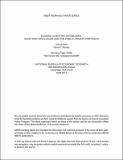Funding Scientific Knowledge: Selection, Disclosure, and the Public-Private Portfolio
Author(s)
Gans, Joshua Samuel; Murray, Fiona E.
DownloadMurray_Funding scientific.pdf (881.5Kb)
OPEN_ACCESS_POLICY
Open Access Policy
Creative Commons Attribution-Noncommercial-Share Alike
Terms of use
Metadata
Show full item recordAbstract
This paper examines argues that while two distinct perspectives characterize the foundations of the public funding of research – filling a selection gap and solving a disclosure problem – in fact both the selection choices of public funders and their criteria for disclosure and commercialization shape the level and type of funding for research and the disclosures that arise as a consequence. In making our argument, we begin by reviewing project selection criteria and policies towards disclosure and commercialization (including patent rights) made by major funding organizations, noting the great variation between these institutions. We then provide a model of how selection criteria and funding conditions imposed by funders interact with the preferences of scientists to shape those projects that accept public funds and the overall level of openness in research. Our analysis reveals complex and unexpected relationships between public funding, private funding, and public disclosure of research. We show, for example, that funding choices made by public agencies can lead to unintended, paradoxical effects, providing short-term openness while stifling longer-term innovation. Implications for empirical evaluation and an agenda for future research are discussed.
Date issued
2012-03Department
Sloan School of ManagementJournal
The Rate and Direction of Inventive Activity Revisited (2012)
Publisher
University of Chicago Press
Citation
Gans, Joshua S. and Fiona Murray. "Funding Scientific Knowledge: Selection, Disclosure and the Public-Private Portfolio." Chapter in NBER book The Rate and Direction of Inventive Activity Revisited (2012), Josh Lerner and Scott Stern, editors. University of Chicago Press (March 2012). p. 51-103.
Version: Author's final manuscript
ISBN
9780226473031
0226473031
ISSN
NBER working paper no.16980